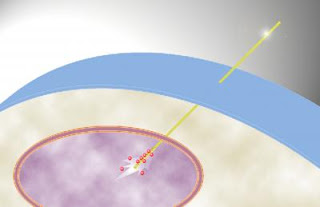CHAMPAIGN, Ill. — Getting an inside look at the center of a cell can be as easy as a needle prick, thanks to University of Illinois researchers who have developed a tiny needle to deliver a shot right to a cell's nucleus.
Understanding the processes inside the nucleus of a cell, which houses DNA and is the site for transcribing genes, could lead to greater comprehension of genetics and the factors that regulate expression. Scientists have used proteins or dyes to track activity in the nucleus, but those can be large and tend to be sensitive to light, making them hard to use with simple microscopy techniques.
Researchers have been exploring a class of nanoparticles called quantum dots, tiny specks of semiconductor material only a few molecules big that can be used to monitor microscopic processes and cellular conditions. Quantum dots offer the advantages of small size, bright fluorescence for easy tracking, and excellent stability in light.
Because the needle is so small, it can pierce a cell with minimal disruption, while other injection techniques can be very damaging to a cell. Researchers also can use this technique to accurately deliver the quantum dots to a very specific target to study activity in certain regions of the nucleus, or potentially other cellular organelles.
"Location is very important in cellular functions," Wang said. "Using the nanoneedle approach you can get to a very specific location within the nucleus. That's a key advantage of this method."
The new technique opens up new avenues for study. The team hopes to continue to refine the nanoneedle, both as an electrode and as a molecular delivery system.
They hope to explore using the needle to deliver other types of molecules as well – DNA fragments, proteins, enzymes and others – that could be used to study a myriad of cellular processes.
"It's an all-in-one tool," Wang said. "There are three main types of processes in the cell: chemical, electrical, and mechanical. This has all three: It's a mechanical probe, an electrode, and a chemical delivery system."
The team's findings will appear in the Oct. 4 edition of the journal Small. The National Institutes of Health and the National Science Foundation supported this work. ###
Editor's note: To contact Min-Feng Yu, call 217-333-9246; e-mail mfyu@illinois.edu. To contact Ning Wang, call 217-265-0913; e-mail nwangrw@illinois.edu.
Contact: Liz Ahlberg eahlberg@illinois.edu 217-244-1073 University of Illinois at Urbana-Champaign
















No comments:
Post a Comment